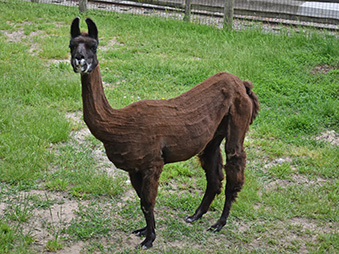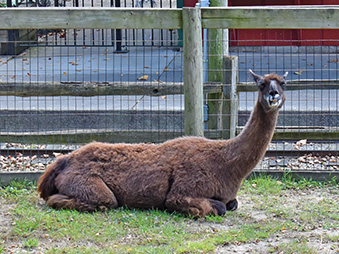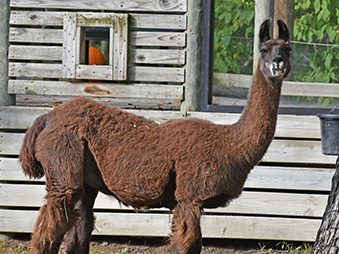Lama glama | Llama
Names: Charlie (Female)



Meet Charlie: The Long-Necked Lady of the Forgotten Forest
With her long neck, curious stares, and a reputation for spitting (more on that later…), Charlie is one of the most expressive—and impressive—residents in the Forgotten Forest. This female llama is a living example of an ancient relationship between humans and animals, one that stretches back thousands of years across the high Andes Mountains of South America.
Not Just a Pretty (Fluffy) Face
Llamas were domesticated from the wild guanaco around 4,000–5,000 years ago in the Andes Mountains of Peru. Unlike their smaller cousins, the alpacas—who were bred for their fiber—llamas were bred for their larger size, strength, and protective instincts.
- A single llama can carry over 120 pounds for up to 18 miles a day, making them the ultimate pack animals.
- They’re also used on farms today to guard livestock like sheep and goats—thanks to their strong herd instincts and natural ability to deter predators.
Mountain Masters
In their native habitats, llamas can be found at altitudes ranging from 7,550 to 13,120 feet above sea level. To put that into perspective, altitude sickness in humans often begins around 8,000 feet—causing dizziness, headaches, rapid breathing, and fatigue. So how do llamas manage?
Adaptions of Course!
Their hemoglobin (a protein in red blood cells that carries oxygen) has a higher affinity for oxygen, meaning it can bind more oxygen at once. This allows llamas to efficiently deliver oxygen to their body—even in thin mountain air.
Built for the Climb
Not only can llamas process oxygen more effectively, but they’re physically built for rugged terrain:
- Padded toes instead of hooves give them better grip on rocky, uneven ground—unlike horses or donkeys, whose hard hooves can slip on steep slopes.
- Their three-chambered stomachs help them absorb maximum nutrients and moisture from sparse vegetation, allowing them to thrive on minimal food and water in harsh environments.
Spit Happens
Yes—llamas spit. And it’s not always the cute kind.
There are three levels of llama spit:
- The Air Puff – A warning mist of air used for low-stakes situations (like “please move”).
- The Shotgun Spit – A quick burst of whatever's in their mouth at the moment. Annoying, but not terrible.
- The Green Stunner – The big one. Llamas will regurgitate partially digested food and stomach acid, launching it as a stinky, green goo. This is usually reserved for serious dominance disputes or someone really invading their space.
Spitting is mostly used for communication within the herd, not with people—so if you respect their space, you’re unlikely to get slimed!
More Than Just Muscle
Llamas are social, intelligent, and expressive animals. They communicate using:
- Ear positions
- Body posture
- Soft humming sounds and alarm calls
- …and, yes, spit
They form strong bonds with each other and with their caretakers—and even respond to familiar voices.
Charlie: Ambassador of the Andes
While Charlie no longer needs to carry packs through treacherous mountain passes, she still embodies all of the amazing traits that make llamas so valuable to Andean people. Their strength, smarts, and adaptability are just as fascinating in Michigan as they are in Peru today and centuries ago!
Whether you’re admiring their stoic stares or learning about their mountain survival skills, Charlie is a reminder of how much we can discover when we slow down, listen, and maybe stay just out of range of a green stunner.
Fact Sheet
Taxonomy
Genus: Lama | Species: glama |
Kingdom: Animalia | Phylum: Chordata | Class: Mammalia | Order: Artiodactyla | Family: Camelidae |
Favorite Enrichment Type
Bamboo boughs to eat and brush against!
Life Span
- In the Wild: (Domesticated)
- In Human Care: 15 to 25+ years
Diet
- In the Wild: Domestic.
- At the Zoo: Special llama chow and hay.
Geographic Range
South American Andes
Habitat
Grasslands, arid plateaus, and cold, semi-arid environments of high-altitude regions.
Llama Fast Facts
- Geographic Range: Native to the Andes Mountains of South America.
- Domestication Timeline: Domesticated from wild guanacos 4,000–5,000 years ago.
- Altitude Tolerance: Can live at altitudes over 13,000 feet, due to their highly oxygenated hemoglobin.
- Foot Adaptation: Padded help keep them stable on rocky terrain.
- Beast of Burden: Can carry over 120 pounds for long distances.
- Domestication: Used today as livestock guardians.
- Green Stunner: Spit comes in three levels—the worst includes stomach acid.
- Pseudo Ruminants: Three-chambered stomachs = highly efficient digestion.
Status: Domesticated (Not Evaluated)
International Union for the Conservation of Nature (IUCN) – Not Evaluated.
How to Find Us
After entering the zoo through the admissions booth, head to the right to enter the Forgotten Forest, in between our Bald Eagles and our Turkey Vulture! There you can find her, munching on hay and special llama chow, greeting visitors, and modeling those signature llama expressions.
